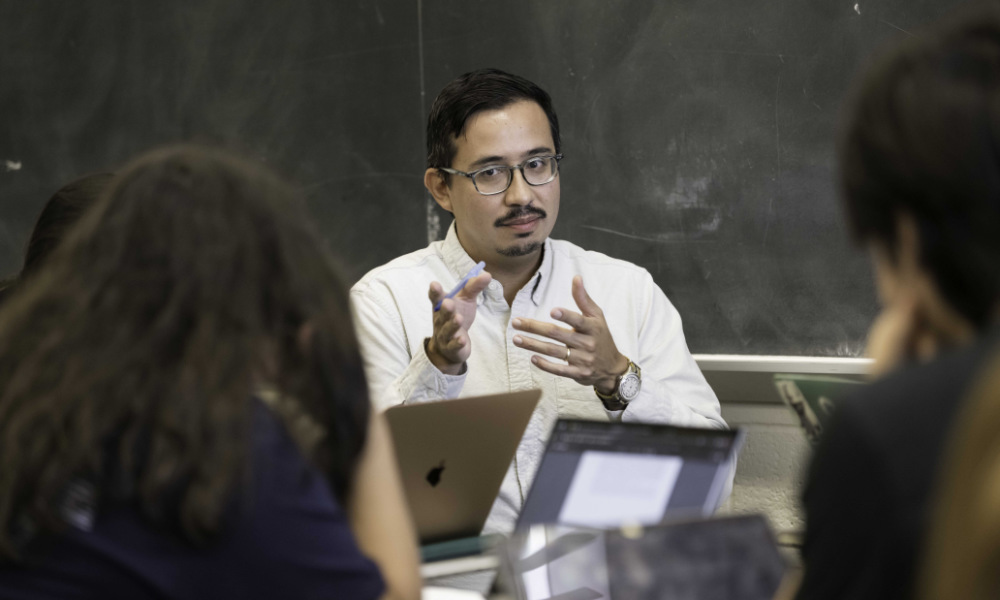How Uganda’s chimpanzees have shaped the assistant professor’s research journey.
Marissa Sobolewski’s road to a scientific career began in Uganda’s Kibale National Park, home to one of the planet’s most diverse populations of primates and the filming location for the 2012 Disney nature documentary Chimpanzee and the 2023 Netflix series Chimp Empire. Learning to embrace scientific complexity while finding a community that values collaborative research has fueled Sobolewski’s drive to discover how the world around us impacts body and mind.
Starting her lab at the University of Rochester Medical Center in 2018, she is now an assistant professor of environmental medicine and of neuroscience as well as a member of the University’s Institute for Human Health and the Environment and the Intellectual and Developmental Disabilities Research Center. The Sobolewski Lab explores how the environment, including exposure to chemicals and other variables like stress, influences brain development and behavior. Studying how the environment influences molecular targets like hormones, epigenetic profiles, and neurotransmitter balance helps us better understand the environment’s role in conditions like ADHD and autism, ultimately improving risk assessment and protecting public health.
How did you get into this line of research?
Sobolewski: My scientific career began with a deep passion for understanding behavior, particularly through working with and training animals. Growing up with German Shepherds fueled my fascination with learning and the impact of social behavior on human actions. Much of our behavioral repertoire is shaped by early learning and social experiences.
During my PhD at the University of Michigan, I aimed to understand human social behavior by studying our closest living relatives, chimpanzees. Primatology offers valuable insights and a window into complex human behaviors. While conducting fieldwork in Uganda, I closely observed chimpanzees documenting their lives. My research explored the relationship between social behaviors and cortisol, a stress hormone. Understanding the complex interplay between hormones and behavior led me to study these systems in more controlled laboratory environments. Living in the beautiful Kibale National Park left me in awe of nature and concerned about human impacts, including chemical pollutants. This led me to the field of behavioral neurotoxicology.

What has your research taught you so far?
Sobolewski: The research I conduct in the lab today focuses on understanding how environmental pollutants and stressors interact. When I first entered toxicology, I focused on how metals like lead impact children’s behavior. Through animal studies, we’ve found that combining exposure to pollutants like lead, methyl mercury, and arsenic with prenatal stress increases toxicity and results in worse behavioral outcomes. These effects often vary by sex. Despite NIH mandates from 15 years ago to include sex as a biological variable, most research in neuroscience, toxicology, and pharmacology still uses only male rodents. The exclusion of females from basic research has also limited our understanding of pregnancy as a unique critical window for how chemical exposures impact maternal health.
Our work expands on this idea that combining exposures can worsen behavioral outcomes by investigating the effects of mixtures of endocrine-disrupting chemicals and modeling exposures to air pollution, which itself is a complex mixture of gases and particles. What my research has taught me so far is that we must embrace the complexity and that scientific discovery lies in our ability to better model the environment at all biological scales. We think that cumulative environmental exposures, or “death by a thousand cuts,” may increase risk for neurobehavioral disorders.
What’s your favorite thing about working here?
Sobolewski: One of the strengths of Rochester is the strong collaborative environment. Whether it’s the air pollution research we conduct with Debbie Cory-Slechta, Günter Oberdörster, Uschi Graham, and Isaac Harris or our partnership with Martha Susiarjo and Matt McCall examining pregnancy as a critical window for endocrine-disrupting chemicals, collaboration allows us to integrate our expertise. Through integration, we develop a clear, detailed picture that helps us translate what we’re seeing in the laboratory to humans. One of the things I love the most about Rochester is that we have a community centered on valuing collaborative research.
The University of Rochester also has a world-renowned animal behavior phenotyping core facility with resources and expertise needed to translate our behavioral studies from rodents to primates to humans and back. This capability allows us to model the complexity of the human environment and its influence on behavioral variability. In addition, our Environmental Health Science Center is home to one of the few whole-body inhalation facilities that allows us to model complex, real-world exposures to ultrafine particulate matter and to conduct focused studies on the health effects of inhaled metals.
When you aren’t in your office or lab, where can we find you?
Sobolewski: One of the most amazing aspects about living in Rochester is that you get the benefits of being in a city environment with amenities like the Rochester Philharmonic Orchestra, the Memorial Art Gallery, the Rochester Museum and Science Center, the Fringe Festival, and the Lilac Festival. At the same time, 15 minutes away you can be kayaking on Lake Ontario or a little bit further and you can enjoy some of the most beautiful hikes in the Finger Lakes or Adirondacks.




